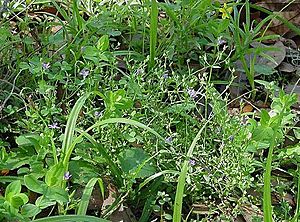Brooksville bellflower facts for kids
Quick facts for kids Brooksville bellflower |
|
|---|---|
 |
|
| Conservation status | |
| Scientific classification | |
| Genus: |
Campanula
|
| Species: |
robinsiae
|
Campanula robinsiae is a very rare flowering plant. It belongs to the bellflower family. People often call it the Brooksville bellflower, Robins' bellflower, or Chinsegut bellflower. This plant grows only in Florida, in Hernando and Hillsborough Counties.
Over the years, the number of these plants has changed a lot. In the early 1980s, people worried it might disappear forever. Today, there are two groups of these plants in Hernando County. There are probably three more groups in Hillsborough River State Park.
Contents
About the Brooksville Bellflower
What it Looks Like
The Brooksville bellflower is a small plant that lives for only one year. It has thin stems that can grow up to 15 centimeters tall. Sometimes, these stems branch out. The stems have small, wing-like ridges. If a stem touches wet ground, it can grow roots from its joints.
The leaves of this plant can be different sizes and shapes. Its flowers are purple and shaped like bells. They are quite small, from 3 millimeters to about one centimeter long.
Where it Lives
This plant likes to grow in wet or moist grassy areas. You can often find it near ponds. Sometimes, it also grows in wet spots in old hardwood forests. These wet spots are called seeps.
Why it's in Danger
The Brooksville bellflower was listed as an endangered species in the United States in 1989. This means it was in danger of disappearing. At that time, only three small groups of plants were known. They lived in wet grasslands.
These plants were threatened by several things. Changes in how water flowed in the area were a problem. Dirty water from pollution also harmed them. People worried that some people might damage the plants. This could happen from vandalism, stepping on them, or collecting them.
Cattle grazing also hurt their homes. This is when cows eat the plants in the area. Another big problem is an invasive plant called skunkvine. This plant grows very fast and takes over the bellflower's habitat.
New Discoveries and Ongoing Threats
Since the plant was first checked for the endangered species list, more groups have been found. However, all of these new groups are still in danger. Their homes are being destroyed or damaged. This is true even for the four groups on protected land. One group is on private land. This group will likely be lost when the land is cleared for new housing.
The protected areas have had many years of drought. This means there hasn't been enough rain. The Brooksville bellflower needs wet conditions to grow well. Water running off nearby areas can also make the local water dirty. This can add too many nutrients to the water. When this happens, non-native plants can grow faster. These plants can then push out the native bellflowers.
A review in 2010 showed that the plant still needs to be protected. Its situation still means it should be an endangered species for now.
See also
 In Spanish: Campanula robinsiae para niños
In Spanish: Campanula robinsiae para niños


